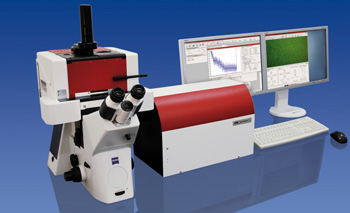JPK Instruments, a world-leading manufacturer of nanoanalytic instrumentation for research in life sciences and soft matter, is pleased to announce the launch of the new ready-to-use optical tweezers system for quantitative measurements the NanoTracker™ 2.
 The NanoTracker™ 2 optical tweezers system from JPK Instruments
The NanoTracker™ 2 optical tweezers system from JPK Instruments
JPK is to unveil the new NanoTracker 2 optical tweezers system at the 2013 Biophysics Annual Meeting being held in Philadelphia, February 2-6. Visitors to the conference and exhibition may have a first impression about the new system first hand at booth #319. (For more details, please visit www.biophysics.org/2013meeting).
Optical tweezers systems have been traditionally built by researchers with a physics or instrument-building background. The potential of using the technique is not in question but for the biologist or chemist, they wish to use the technique for research in the knowledge that the ability to handle molecules with absolute control of forces is beyond their experimental capability. They are not electronics or mechanical engineers. For them, the need is a ready-to-use system with the familiarity of a platform of a standard optical microscope and a friendly, fully supported software system that delivers them a simple to use but extremely advanced experimental optical tool bench.
JPK, with a reputation as the "force tool shop" for researchers in techniques such as Bio AFM and force spectroscopy, decided to develop a system to meet the needs of the practising applications scientist. These are people who work in the areas that include biophysics, biochemistry, polymer science, biology, single molecule mechanics groups, cell sorting and manipulation. In total, this means all people who are working with small particles interacting with their environment - and measuring their forces. This optical tweezers platform provides force and interaction measurement in parallel with optical microscopy using complementary spectroscopic techniques.
By talking with users of optical tweezers systems, both the home-builders and of their first-generation system, JPK has come up with a system which minimizes user interactions on a platform which has been built with increased stability and lower noise to improve detection. With force measurements being so important to users, JPK has enabled new open routines for the user to design their own enhanced measurements. It also provides new force clamp and signal multiplexing and de-multiplexing capabilities by utilizing acousto-optic deflectors which spatially control the optical beams.
As CTO, Torsten Jähnke, describes the system, "We have developed a more integrated-design approach than before. For example, it makes single molecule experiments such as DNA stretching or cell/particle experiments much more straight forward. This saves time for the user who now has the full control of all parameters in one control and analysis software package."
The new system comes with an overall improved performance especially for the beam steering through highly accurate pivot-point piezo mirrors and the detection system which benefits from a complete redesign of the optical pathway. The resulting better linearity and diminished crosstalk improve all sensitive force measurements. New functions are also implemented for a more precise trap calibration which allows the extraction of additional material properties.
The full capabilities of the system are described in detail in a new eight page product brochure which is available free at JPK's web site. For this and details about JPK's many specialist products and applications for the nano and biological sciences, visit the JPK Instruments web site.